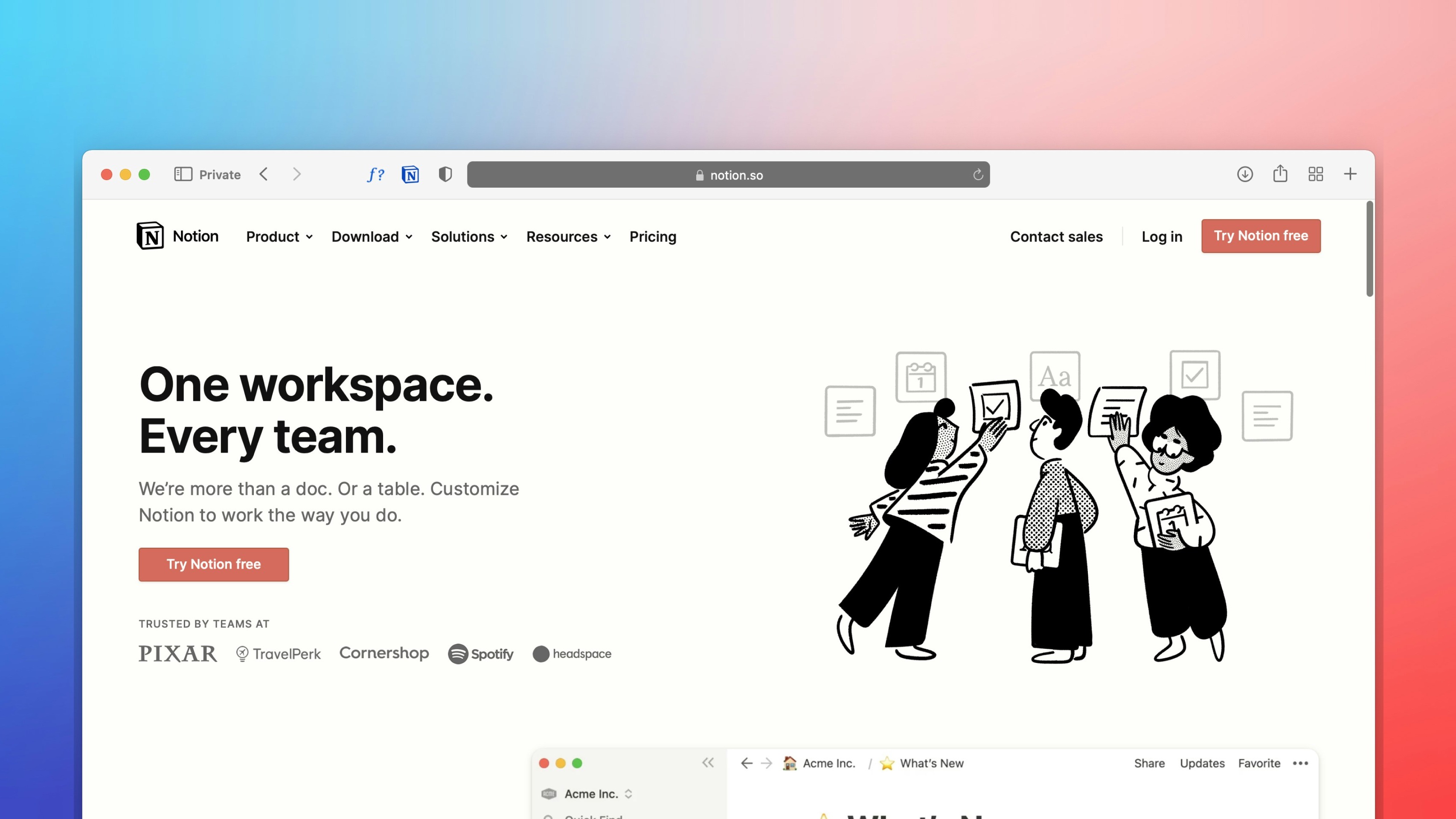 Freelancer tips
Freelancer tips Notion: What It Is, What It’s For, and How to Use It in Your Daily Life
Want to better organize your life and work? Notion can help boost your productivity. Click here to discover what this software is and what it’s used for.



In today’s competitive freelance market, having a standout portfolio is more crucial than ever.
According to a study by Slash Workers, while the best source of work for freelancers is word of mouth and referrals, portfolios come in second, with 48% of freelancers saying it’s where they get their clients.
This statistic highlights just how important it is for freelancers to present their work in a way that not only captures attention but also sets them apart from the competition.
In this article, we’ll delve into essential portfolio templates for freelancers and explore practical tips for creating a compelling showcase of your work.
We’ll cover the benefits of using professional templates, offer advice on tailoring your portfolio to highlight your unique skills, and provide actionable steps to ensure your portfolio shines in 2025.
By the end, you’ll be equipped with the tools and knowledge needed to build or enhance your portfolio, making a lasting impression on potential clients.
If you're a freelancer, you might be wondering why a portfolio is such a big deal.
Simply put, a portfolio is your professional showcase — a tool that helps you present your skills, attract clients, and stand out in a crowded marketplace.
Let’s break down how a well-crafted portfolio can benefit you in these key areas:
A portfolio acts as a visual resume, allowing you to display your best work in one easily accessible place.
Unlike a traditional resume that lists your skills and experiences, a portfolio shows them in action.
For instance, if you’re a graphic designer, your portfolio could include samples of logos, website designs, and print materials you’ve created.
This not only demonstrates your capabilities but also allows potential clients to see the quality and style of your work firsthand.
In the freelance world, first impressions matter.
A strong portfolio can be a powerful tool to attract clients by showcasing the breadth and depth of your work.
It helps you stand out from competitors who might not have a well-organized or visually appealing portfolio.
A portfolio gives clients a snapshot of what you can deliver, which can make them more likely to reach out to you for projects.
The freelance market is increasingly competitive, and having a standout portfolio can set you apart from others.
A well-designed portfolio not only highlights your skills but also reflects your personal brand and style.
It’s an opportunity to make a memorable impression and show potential clients why they should choose you over others.
Building a standout portfolio is crucial for showcasing your skills and attracting clients.
Here’s a step-by-step guide to help you create a compelling and effective portfolio:
Define your objectives: Clarify what you want to achieve with your portfolio (e.g., attracting specific types of clients).
Choose the right platform: Discuss various platforms where freelancers can build their portfolios, like WordPress, Wix, or Behance.
Choose your best work: Select projects that highlight your skills and achievements.
Keep it simple and navigable: Emphasize the importance of a clean, user-friendly design.
Include client testimonials and case studies: Build credibility with positive feedback and detailed case studies.
Regularly update your portfolio: Keep your portfolio current with your latest work and achievements.
Designing a portfolio that catches the eye and effectively showcases your work can make a huge difference in attracting clients.
Here’s a guide to help you layout your portfolio in a way that’s visually appealing, easy to navigate, and relevant to your target audience:
Home page: Your portfolio should start with a clear and engaging home page that immediately tells visitors who you are and what you do. Include a brief introduction or tagline that summarizes your expertise.
About page: Include a section that details your background, skills, and professional journey. This helps potential clients understand your qualifications and what sets you apart. Share your education, certifications, and key achievements in a brief yet informative manner.
Project gallery: Create a dedicated section for your projects. Organize this gallery in a way that highlights your best work first. Use high-quality images and include brief descriptions or case studies to provide context.
Testimonials and case studies: Feature feedback from past clients to build credibility and showcase your successful collaborations, and provide detailed examples of projects you’ve worked on, including the problem, solution, and results. This demonstrates your problem-solving skills and the impact of your work.
Contact information: Make it easy for potential clients to get in touch with you by including clear contact information or a contact form. Place call-to-action buttons, like “Get in Touch” or “Request a Quote,” prominently.
Creating a standout portfolio is essential for freelancers, but avoiding common pitfalls is just as important.
Here are key mistakes to steer clear of:
Overloading with too much content: Including every project you’ve ever worked on can overwhelm potential clients. Focus on a curated selection of your best work to keep your portfolio impactful and relevant.
Forgetting to include contact information: Your portfolio is useless if clients can’t reach you. Make sure to prominently display your contact details, including your email address, phone number, and links to your social media profiles or contact forms.
Low-quality images: Your portfolio should reflect the quality of your work. Avoid using blurry or pixelated images. Always upload high-resolution, well-composed visuals to present your work at its best.
Outdated work: Displaying older or irrelevant projects can make your portfolio seem stale. Regularly update your portfolio to feature recent work that showcases your current skills and aligns with industry trends.
Overcomplicated design: A complex or confusing design can detract from your work. Keep your portfolio clean and simple with easy navigation to ensure that potential clients can easily browse and focus on your work.
Choosing the right portfolio template is crucial for showcasing your work effectively and attracting clients.
The best template will depend on your specific needs, the nature of your work, and how you want to present yourself.
Here’s a breakdown of some of the best types of templates for different freelance fields, along with a few examples to consider:
Ideal for: Designers, photographers, and creatives who want to let their work take center stage.
Uncode is a popular choice for creatives.
It offers a range of minimalist designs with easy-to-use customization options, perfect for showcasing your portfolio without distraction.
This template typically uses a lot of white space, simple navigation, and high-quality image displays.
It’s perfect for portfolios where the focus is on visual content.
Ideal for: Artists, illustrators, and photographers who have a diverse collection of work to display.
Oshine offers a grid-based layout with various styles and customization options, allowing you to display your work in a clean, organized manner.
Grid-based templates organize your work into neatly arranged blocks, making it easy for visitors to browse through different projects.
This layout is particularly effective if you have multiple pieces of work in different categories.
Ideal for: Web developers, UI/UX designers, and digital marketers who want to demonstrate their skills through an engaging user experience.
Salient is known for its interactive features and visually striking design options.
It’s perfect for portfolios that want to showcase advanced web design skills and creativity.
This template includes interactive elements like sliders, hover effects, and animations.
It’s great for showcasing your ability to create dynamic and engaging digital experiences.
Ideal for: Freelancers in any field who want to provide a comprehensive view of their work, including detailed project descriptions and professional background.
WordPress Portfolios are versatile template that includes sections for your resume, project details, and client testimonials, offering a well-rounded view of your professional profile.
These templates often combine a traditional resume format with project showcases.
They include sections for your professional history, skills, and detailed case studies or project descriptions.
Ideal for: Freelancers who work with businesses and need to present a polished, professional image.
Astra is a clean, professional template that can be customized for various industries.
It offers a range of layout options and integrates well with business-focused content.
This template have a more formal design with a focus on business professionalism.
It typically includes sections for services, client testimonials, and contact information, and is often suited for service-based freelancers.
Absolutely, using a template for your portfolio is not only okay but often a smart choice for freelancers.
Templates provide a ready-made structure that can help you create a professional-looking portfolio without needing advanced design skills or a hefty budget.
By using a portfolio template, you can speed up your portfolio creating process and start booking clients sooner!
Choosing the right program to create your portfolio is essential for effectively showcasing your work and aligning with your professional goals.
Start by considering your audience: if you’re in a creative field like design or photography, opt for a program that offers visually dynamic templates, such as Adobe Portfolio or Squarespace, to highlight your high-quality images.
For more traditional business services, platforms like WordPress or LinkedIn might be better suited for a professional and straightforward presentation.
Prioritize usability by selecting a program with an intuitive interface that ensures easy navigation for visitors, such as Wix or Squarespace, which provide user-friendly drag-and-drop editors.
Additionally, ensure that the program allows for ample customization of colors, fonts, and layouts to reflect your personal brand and style — WordPress and Adobe Portfolio are excellent for this purpose.
Ultimately, the best choice will depend on your specific needs, whether you require extensive flexibility or a streamlined setup, so choose a program that aligns with your goals and enhances your portfolio’s effectiveness.
A well-crafted portfolio is a vital tool for freelancers aiming to showcase their skills and attract the right clients.
By choosing the right template, focusing on high-quality work, and ensuring ease of navigation, you can create a portfolio that effectively highlights your expertise and makes a strong impression.
Whether you opt for a minimalist design or a more dynamic layout, remember to keep your target audience in mind and tailor your portfolio to meet their expectations.
Regular updates and incorporating client testimonials will further enhance your portfolio’s credibility and appeal.
Additionally, managing the financial aspects of freelancing can be as crucial as curating your portfolio.
Tools like DolarApp can streamline your financial management, helping you track expenses, manage invoices, and stay on top of your budgeting.
By integrating efficient financial management with a compelling portfolio, you’ll not only showcase your professional capabilities but also ensure that your freelance business operates smoothly and effectively.
Balancing both sides of your freelance career will set you up for long-term success and growth.

The world has borders. Your finances don’t have to.
 Freelancer tips
Freelancer tips Want to better organize your life and work? Notion can help boost your productivity. Click here to discover what this software is and what it’s used for.

 Freelancer tips
Freelancer tips Project chaos? Learn how Trello can help you organize tasks and improve your productivity.

 Freelancer tips
Freelancer tips ClickUp can make any freelancer more productive. Discover what it is, how it works, and the advantages this tool offers you


